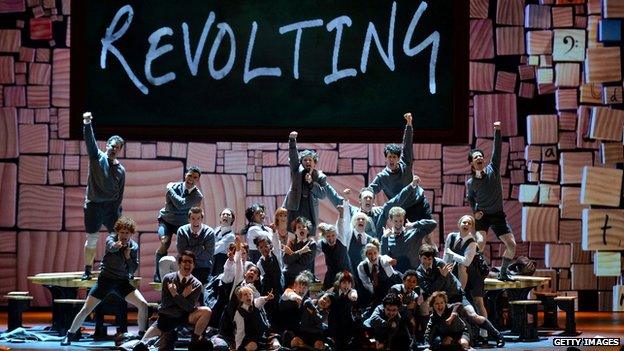More plays staged at top UK theatres since 2009
- Published

More plays were staged by the UK's most-subsidised theatre companies in 2014 compared with five years earlier, despite fears about funding cuts, BBC research suggests.
A total of 200 full plays and musicals were staged by 20 of the venues and touring production companies with the biggest government grants in 2014.
That is up from 163 full plays in 2009.
Production levels at a further 42 theatre companies, which receive smaller grants, remained roughly level.
The number of new plays also rose between 2009 and 2014, particularly at the best-funded venues, despite fears that new writing is harder to sell.
The research looked at 62 subsidised UK theatre companies - about three-quarters of all those that get at least £250,000 per year, create their own productions and were open in both 2009 and 2014.
Annual government funding for those 62 theatres dropped by 1.6% in that time, not including inflation.
In recent years, subsidised theatre companies have expressed fears about the impact of funding cuts.
Some of the best-funded theatre companies have made up for this by increasing their private fundraising and giving more of their hit shows lucrative runs in the West End, Broadway and elsewhere.
However actors' union Equity said the number of weeks actors had worked had fallen - suggesting that productions were having shorter runs or using smaller casts.
UK subsidised theatre, 2014
395
Full productions
9%
rise on 2009
-
172 new plays, up 26% on 2009
-
37% directors were women, up from 33% in 2009
-
36% writers of new plays were women, up from 32% in 2009
-
57% of actors were male, 43% female
More shows at top theatres:
The 62 venues staged a total of 395 full professional productions and co-productions in 2014, compared with 361 in 2009.
Of these, the 20 best-funded theatres - which receive more than £1m per year from government sources - put on 200 plays and musicals in 2014, compared with 163 in 2009 - a rise of 23%.
Production numbers at 42 lesser-funded theatre companies - which all receive between £250,000-£1m - went from 198 in 2009 to 195 in 2014.
More new plays:
A total of 137 new plays and musicals were staged by the 62 theatre companies in 2009. This rose to 172 in 2014 - a rise of 26%.
The number of new plays rose by 41% at the 20 best-funded theatres, and rose by 15% at the other companies.
Slow progress to equality:
Male actors took 57% of all roles, with 43% for women in 2014.
Men accounted for more than six in 10 writers and directors - but the numbers have evened up a little since 2009.
Among writers of new plays, there were 104 men (68%) and 50 women (32%) in 2009. Last year, there were 115 men (64%) and 65 women (36%).
Among directors, the selected venues used 166 men (67%) and 80 women (33%) in 2009. Last year, there were 156 men (63%) and 90 women (37%).
The 20 best-funded companies, which all get more than £1m per year, include the National Theatre, Royal Shakespeare Company (RSC), National Theatre of Scotland, Plymouth Theatre Royal and Birmingham Rep.
The other 42, which receive between £250,000 and £1m per year, range from the Traverse in Edinburgh to the Bolton Octagon and touring companies like Northern Broadsides, Headlong and Paines Plough.
The government funds such theatres to create a wider range of shows - including new or more experimental work - in more locations and at more affordable prices than could be found in the West End or on the commercial circuit.
'More resourceful'
Some shows created by subsidised theatres do go on to the West End or Broadway if they are hits. This is one way subsidised theatres can earn extra income - but that is more difficult for smaller operations and those outside London.
The National Theatre, which gets the biggest subsidy of any theatre in the UK, has also been the most successful when it comes to boosting income from its hit shows.
War Horse, One Man Two Guvnors and The Curious Incident of the Dog in the Night-Time all started at the National Theatre on London's Southbank and went on to have runs elsewhere in the UK and abroad in 2014.
The RSC, the Royal Court, National Theatre of Scotland and The Young Vic are among the others to have had successful commercial transfers in 2014.
Many small and medium-sized companies are attempting to increase income from activities like hospitality, catering and education work.

Analysis: Ian Youngs, BBC News arts reporter
These figures suggest that there is a premier league of top theatre companies, and the gap between those and the rest is growing.
The top theatres have become more commercial and more ingenious in order to expand their work - while increasing "risky" new writing and resisting the temptation to retreat to safe shows.
Below the top tier, small and medium-sized venues are also working hard to find new income. But their options are more limited.
It could be argued that the long-feared cuts have not fully kicked in - and everyone in the theatre world is still petrified that the worst is yet to come.

Rachel Tackley, president of trade body UK Theatre and director of English Touring Theatre, said the industry was "working together to make what there is go further".
"The bigger houses are definitely becoming more resourceful and doing more co-productions," she said.
"The easy thing would be to do less. The money gets less, we do less. Actually I think the opposite has been proven to be the case.
"As the money gets tighter and we're more squeezed, then we get more and more resourceful. My worry is to what extent you can continue that."
Employment 'collapse'
But Equity said the number of weeks actors had worked at many of the best-funded theatres had dropped since 2009.
"We don't think that more titles being done by these 20 theatres can be read to be a sign of the theatres not being impacted by funding cuts, especially when you look at the collapse in employment in most of those theatres," assistant general secretary Martin Brown said.
Government funding for theatre in the UK comes from the Arts Councils of England, Wales and Northern Ireland, Creative Scotland and the Scottish Government.
The average funding cut of 1.6% over the last five years does not account for inflation, which has risen by around 16.5% since 2009. Nor does it include cuts to local government grants or other sources of revenue.
- Published4 February 2015

- Published4 February 2015

- Published4 February 2015
jonathankeenan.jpg)